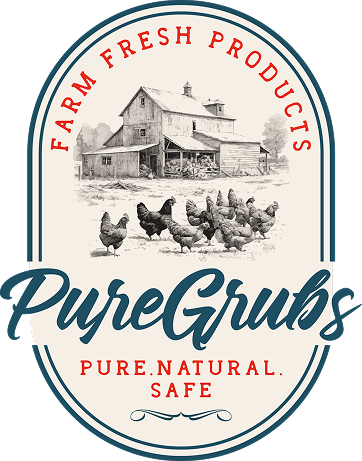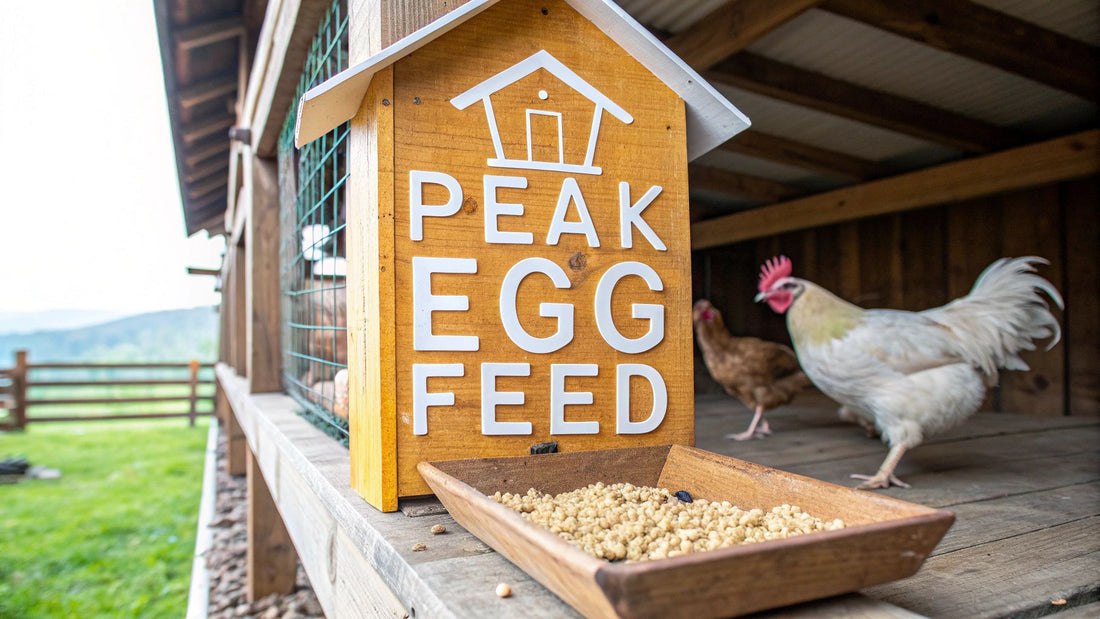
What to Feed Laying Hens for Peak Egg Production
Share
So, what's the best thing to feed a laying hen? The simplest, most direct answer is a high-quality commercial layer feed. This is the absolute cornerstone of their diet—the complete nutritional engine that fuels consistent egg production and keeps your flock healthy.
Nothing else can truly replace the balanced power of a good layer feed.
The Unbeatable Foundation of a Laying Hen Diet
Picture a laying hen as a tiny, feathered athlete. Every single day, her body performs the demanding task of creating a perfect egg, and she needs a precise fuel mix to do it right. This isn't something you can eyeball with kitchen scraps or a random scoop of grains.
A dedicated layer feed is scientifically formulated to provide the exact balance of protein, calcium, vitamins, and energy she needs. Without that solid foundation, you’ll start seeing problems—fewer eggs, weak or brittle shells, and even long-term health issues for your hen.
The Science Behind the Scoop
Every handful of a quality layer feed is a complete, balanced meal. It’s designed that way on purpose. The global poultry feed industry, as detailed by market analyses from sources like Grand View Research, draws a very clear line between feed for meat birds (broilers) and feed for egg-layers.
Layer feeds contain specific nutrient ratios, including balanced amino acids for feather and muscle health, energy for scratching and foraging, and—most importantly—a hefty dose of calcium for strong eggshells. This precision is exactly why a commercial feed is so critical. It takes all the guesswork out of the equation.
A classic mistake new chicken keepers make is getting a little too generous with treats. Remember the 90/10 rule: the complete layer feed should make up at least 90% of your flock's total diet.
To really understand what's in that bag of feed, let's break down the key players. Each ingredient has a specific job to do.
Essential Nutrients in a Laying Hen's Diet
This table gives a quick snapshot of the most important nutrients your hens need from their daily feed and why they matter so much.
| Nutrient | Required Percentage | Primary Role |
|---|---|---|
| Protein | 16-18% | Egg formation, feather growth, and overall body maintenance. |
| Calcium | 3.5-4.5% | Absolutely critical for forming strong, durable eggshells. |
| Phosphorus | ~0.4% | Works with calcium for shell strength and bone health. |
| Vitamins (A, D, E) | Varies | Supports immune function, calcium absorption, and reproductive health. |
| Fats/Energy | ~3-5% | Provides the energy needed for daily activities and laying eggs. |
As you can see, it's a finely tuned balancing act. Too much or too little of any one thing can throw the whole system off.
Building Strong Eggs from the Inside Out
The most obvious sign of a great diet is a basket full of beautiful, strong eggs. Those smooth, tough shells are a direct result of getting enough calcium. Layer feeds are packed with it, but a hen's body uses a lot of it.
Every night, she pulls a significant amount of calcium from her own bones to create the eggshell. Her feed's job is to replenish those stores every single day. You can dive deeper into the science behind this in our guide to high-calcium chicken feed.
Ultimately, knowing what to feed your laying hens starts with respecting the role of a complete layer feed. While healthy treats and supplements are a fun part of chicken keeping, they are just accessories to the main meal, never a replacement for it.
Decoding the Different Types of Chicken Feed
Walking into a feed store for the first time can be overwhelming. You're faced with a wall of bags labeled mash, crumbles, and pellets, and it's not immediately obvious which one your flock needs. Choosing the right feed is about more than just nutrition; it's also about the physical form of the food.
Think of it like this: some people prefer granola, others like oatmeal. Your chickens can have preferences too, but more importantly, each feed texture offers practical pros and cons for you as their keeper. The form you choose can affect everything from wasted feed to how clean your coop stays.
Mash vs Crumbles vs Pellets
So, what's the real difference between mash, crumbles, and pellets? They all start with the same basic ingredients, but they're processed differently. Getting this right helps you match the feed to your flock's age, their eating habits, and your own management style.
To make things a bit clearer, here’s a quick comparison of the three main feed forms.
Comparing Feed Forms Mash vs Crumbles vs Pellets
| Feed Form | Best For | Pros | Cons |
|---|---|---|---|
| Mash | Baby chicks (0-8 weeks) | Easy for tiny beaks to eat. | Very messy; chickens can easily flick it out of feeders, leading to waste. Can be difficult for older birds to eat efficiently. |
| Crumbles | Pullets and picky eaters | A good transition between mash and pellets. Easier to eat than pellets for some birds. | Can still be a bit messy, though less so than mash. |
| Pellets | Adult laying hens | Minimizes waste significantly. Ensures a complete, balanced bite every time. Easy to store and handle. | Can be too large or hard for very young birds or some bantam breeds. |
Ultimately, pellets are often the go-to for adult hens because they're so efficient. Since the feed is compressed into a solid nugget, hens can't pick out just their favorite grains—they get a complete nutritional package in every bite. This also means less feed scattered on the coop floor, which saves you money and keeps things tidier.
The Chicken Feed Timeline From Chick to Layer
Just as important as the feed's texture is its formula. A hen's nutritional needs change dramatically as she grows from a fluffy chick into a productive egg-layer. Feeding the right formula at the right time is absolutely crucial for her long-term health.
The infographic below gives you a glimpse into the key ingredients that are carefully balanced in these specialized feeds.
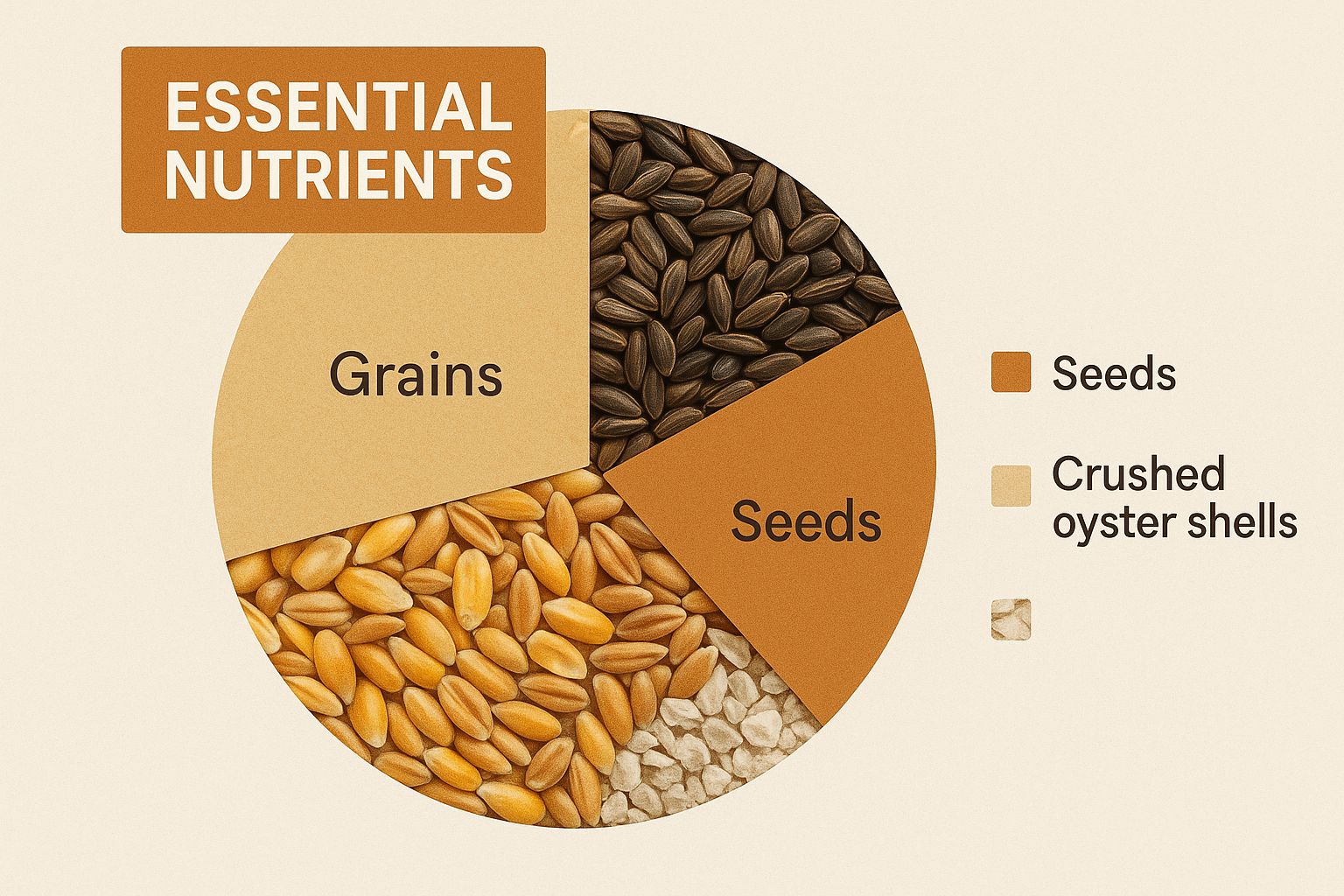
As you can see, it's a precise blend of grains, proteins, and minerals like calcium, all designed to meet a hen's dietary demands at a specific stage of life.
Here's how that journey breaks down into three key stages:
-
Starter Feed (0-8 Weeks): This is a high-octane fuel for baby chicks. With a protein content of 20-24%, it supports the explosive growth that turns a tiny chick into a feathered-out bird in just a few weeks. All that protein is essential for developing strong bones, muscles, and healthy feathers.
-
Grower Feed (9-17 Weeks): Welcome to the awkward teenage phase. As your pullets mature, their need for super-high protein drops off a bit. Grower feed dials it back to 16-18% protein and, critically, contains less calcium than layer feed. This is deliberate—too much calcium before they start laying can cause permanent kidney damage.
-
Layer Feed (18+ Weeks): This is the big leagues. When your hens are nearing the point of lay, it's time to switch to a layer feed. It keeps the protein steady at 16-18% but cranks up the calcium to 3.5-4.5%. This extra calcium is non-negotiable; it goes directly into forming strong eggshells every single day, so the hen doesn't have to pull it from her own bones.
Making the transition to layer feed is a crucial step. It should happen around 18 weeks of age or when you see the very first egg, whichever comes first. This ensures her body is fully prepared for the demanding work of egg production.
By understanding both the form and the formula, you can walk into that feed store with confidence. You’ll know exactly which bag to grab for your flock, setting them up for a long, healthy, and wonderfully productive life.
Essential Supplements Your Flock Cannot Ignore
Even the best-quality layer feed is just the foundation of your flock’s diet. Think of it as the main course of a perfectly balanced meal. To really thrive, your hens need a couple of critical "side dishes" that play distinct, non-negotiable roles in their health: oyster shell and grit.
It's easy to get these two mixed up, but they serve completely different purposes. One is for building strong eggs, and the other is for actually digesting their food. Skipping either one can lead to some serious health and production issues down the road, even if you're providing top-of-the-line feed.
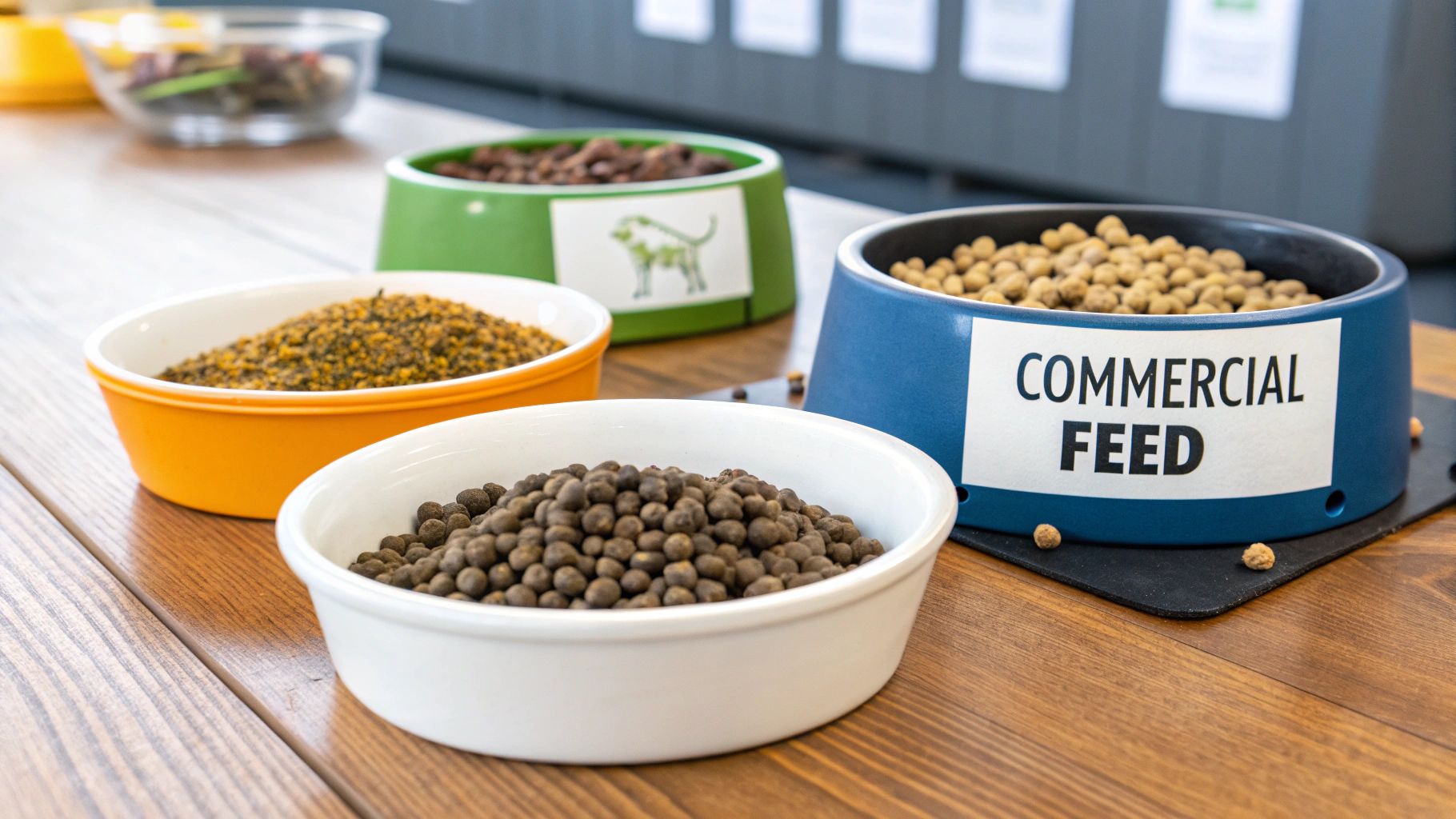
Oyster Shell: The Eggshell Powerhouse
Imagine a hen has a personal "calcium bank" she has to draw from every single day to form a strong eggshell. Her layer feed helps make deposits into that bank, but the demand for calcium is so high that she often needs an extra source to keep her account from going into the red. That's where oyster shell comes in.
Oyster shell is basically pure, slow-release calcium carbonate. When you offer it "free-choice" in a separate container, you're letting each hen decide for herself exactly how much she needs. This is so important because a hen’s calcium requirements change constantly based on her age, where she is in her laying cycle, and even the weather.
By providing free-choice oyster shell, you prevent hens from raiding their own skeletal system for calcium. If a hen can’t get enough from her diet, her body will pull it directly from her bones. This leads to a condition much like osteoporosis, causing weak bones and fractures.
It's a small addition to your setup that pays huge dividends in egg quality and hen health. If you want to dive deeper, you can explore more about the best calcium supplement for chickens in our detailed guide.
Grit: The Chicken's Teeth
Okay, so if oyster shell is the calcium bank, then grit is basically the chicken's teeth. Chickens don't chew their food; instead, they have a powerful muscle called the gizzard that grinds everything up. But the gizzard can't do its job alone—it needs tools.
Grit provides those tools. These are just small, insoluble stones (think tiny bits of granite) that the hen swallows and stores in her gizzard. As those strong gizzard muscles contract, the grit pulverizes tough grains, seeds, insects, and anything else she forages into a digestible mash.
Grit is absolutely essential in a couple of key scenarios:
- Foraging Flocks: If your chickens free-range or get any food besides their complete feed (like kitchen scraps, scratch grains, or Pure Grubs), they must have access to grit.
- Whole Grain or Mash Diets: Birds eating less-processed feeds need grit to break down the larger ingredients efficiently.
Without it, a hen simply can't digest her food properly. This can lead to serious problems like crop impaction, poor nutrient absorption, and a general decline in health.
Just like oyster shell, grit should be offered in a separate, free-choice feeder. Your hens are smarter than we give them credit for—they will instinctively eat it only when they need it. Providing both ensures your flock has everything required for both strong reproduction and robust digestion, completing the picture of a truly optimal diet.
What's Really Behind the Cost of Feeding Your Flock?
When you’re standing in the feed store, it's easy to just look at the price on a bag of layer feed. For anyone raising chickens, feed is hands-down the biggest, most consistent expense. But that number on the price tag isn’t arbitrary; it’s the final stop on a long, winding road of global events.
Once you understand what goes into that cost, you start to see each scoop of feed differently. It's not just grain—it's a valuable resource shaped by economics, weather patterns thousands of miles away, and even international health scares. This perspective makes smart feeding and cutting down on waste feel less like a chore and more like a crucial part of keeping a healthy, sustainable flock.
The Global Domino Effect in Your Feed Bin
It might seem strange, but the price of that bag of chicken feed is surprisingly tied to what's happening on the world stage. Think about it like the cost of your morning coffee. If a major drought hits Brazil, the price of coffee beans goes up everywhere. The very same thing happens with the ingredients in your chicken’s dinner.
Several big factors can make feed prices jump, sometimes with very little warning:
- Raw Ingredient Costs: Most layer feeds are built on a base of grains like corn and soybeans. When a major grain-producing region gets hit with a flood or a drought, the global supply tightens up, and prices climb for everyone.
- Energy and Shipping: Just getting the corn from the field to the mill, then getting the finished feed to your local store, burns a lot of fuel. When gas prices spike, that cost gets passed all the way down to the final bag you buy.
- Disease Outbreaks: Major events, like an outbreak of Avian Influenza, can throw a wrench in the entire poultry industry. These disruptions impact everything from how many birds are producing to what trade restrictions are in place.
These issues create a domino effect that starts in international commodity markets and ends right in your backyard coop.
A Quick Look at Global Feed Production
The sheer scale of the global feed market is massive, and a problem in one part of the world can easily be felt in another. Recent data gives us a clear picture of just how interconnected everything is.
For example, in 2022, Europe was the world's second-biggest producer of layer feed, cranking out around 30.7 million tons. But their production actually dipped by 1% that year, thanks to pressures from avian flu and skyrocketing ingredient costs. At the same time, Latin America saw its production grow by 3% to 24.5 million tons. You can dig deeper into these numbers in the global poultry feed market report.
This global view really drives home that the feed in your bin is part of a huge, interconnected system. A poor harvest or a disease outbreak on the other side of the planet can directly affect how much it costs to keep your flock healthy and happy.
Seeing the bigger picture helps shift your mindset from just "buying feed" to strategically managing a truly valuable resource.
Why Fighting Waste Is Your Smartest Move
Once you appreciate the real value packed into every single pellet, making sure none of it goes to waste becomes a no-brainer. Every bit of feed that gets kicked out of the feeder, pooped on, or stolen by mice is literally money down the drain. It’s like a leaky faucet—a few drips here and there might not seem like much, but they add up fast.
The good news is that protecting your investment is pretty straightforward.
- Get the Right Feeder: A well-designed feeder is your first line of defense. Look for ones with deep troughs or special guards that make it hard for your hens to flick feed all over the ground.
- Lock It Down from Pests: Store your feed in a sturdy, sealed container that rodents can't chew through. This not only saves you money but also keeps your flock safe from diseases that pests can carry.
- Keep It Clean and Dry: Feed that gets wet or dirty can quickly grow mold, which is toxic to chickens. Make sure your feeders are under cover, away from rain, and placed where they won't get contaminated with droppings.
By focusing on these simple but powerful habits, you’re not just saving money. You’re respecting the resources that went into making that feed and ensuring your hens get all the nutrition they need to stay healthy and keep laying those delicious eggs.
Mastering Your Flock's Daily Feeding Routine
Knowing what to feed your laying hens is half the battle. The other half—the part that really unlocks their potential—is knowing how to feed them. This is where we move from theory to the daily reality of raising a flock. It’s about creating a simple, effective routine that fuels their high metabolism, lets them act like chickens, and cuts down on expensive waste. Get this right, and you're not just doing chores; you're building a system for happy, healthy, and productive hens.
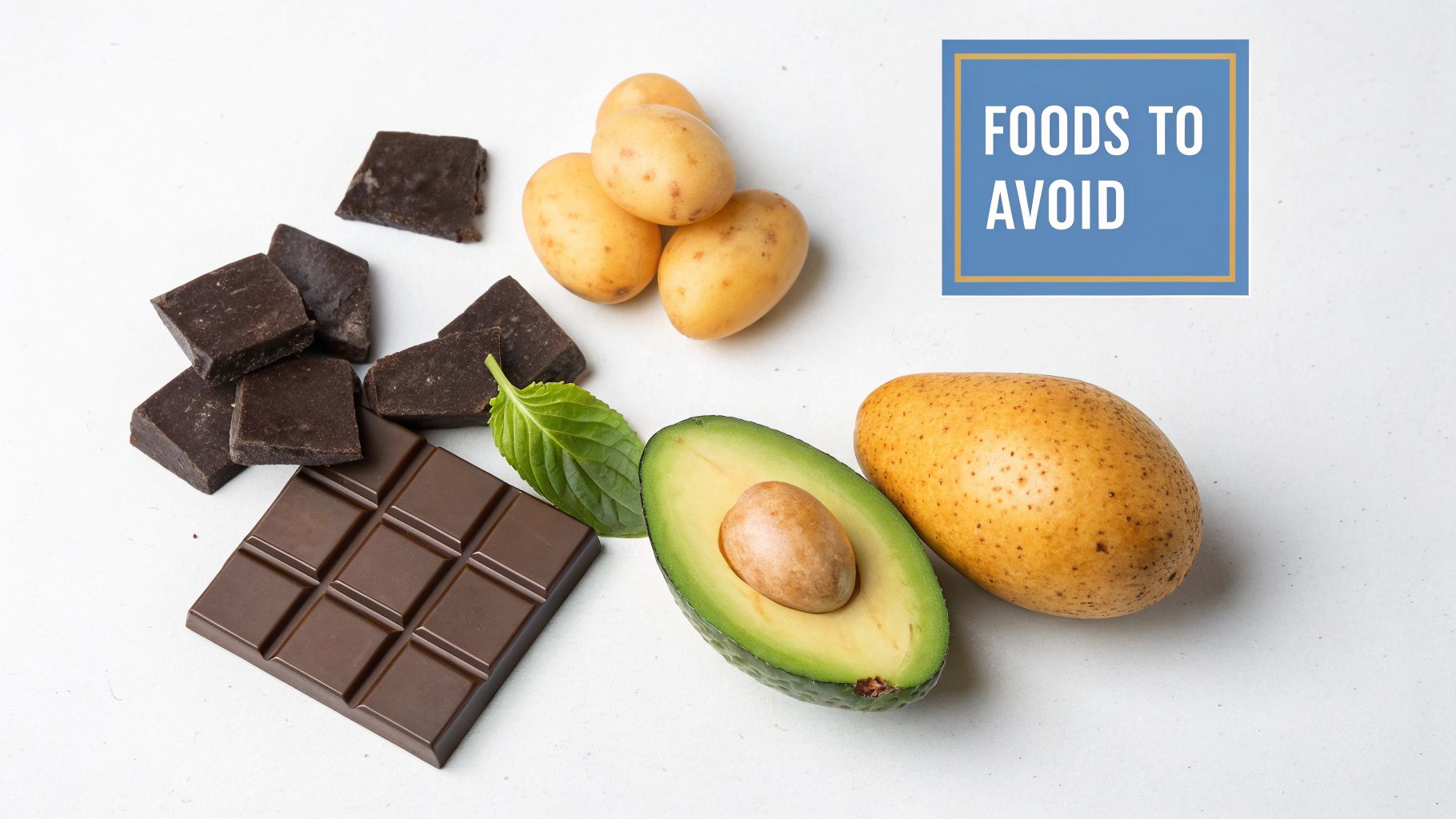
The Gold Standard: Free-Feeding for Layers
Unlike a dog who gets a couple of meals a day, laying hens thrive on a method called free-feeding. It’s exactly what it sounds like: giving them constant access to their layer feed all day long. A hen’s metabolism is an absolute furnace, especially when she’s churning out an egg every 24-26 hours. She needs to peck and eat small amounts whenever the mood strikes to keep her energy up and fuel that incredible production line.
If you start restricting their food, you’ll see problems. It can stress them out, causing egg production to drop, and can even spark some squabbles in the flock. Keeping the feeder full lets every hen—from the boldest to the most timid—eat what she needs, when she needs it, without any drama.
You'll notice your hens eat most actively first thing in the morning and right before heading into the coop for the night. That last meal is crucial, as it provides the energy and calcium they need to build a strong eggshell overnight.
Choosing a Feeder That Fights Waste
Your choice of feeder is a bigger deal than you might think. Chickens are messy eaters. They love to scratch and flick their feed everywhere, and a bad feeder design makes this easy for them. Once that feed hits the ground, it gets mixed with poop and bedding, becoming contaminated and unappetizing. That’s not just waste; it’s literally throwing money away.
To stop the spillage, invest in a feeder designed to outsmart a chicken:
- Treadle Feeders: These are brilliant. A hen steps on a platform, and a lid pops open, giving her access to the food. This keeps the feed clean, dry, and safe from pests.
- Hanging Feeders: Simply raising the feeder so the lip is about level with the hens' backs makes it much harder for them to scratch feed out with their feet.
- No-Waste Feeders: You can find all sorts of commercial and DIY options that use PVC pipes with ports or elbow joints. A hen sticks her head in to eat, containing the mess perfectly.
A good feeder doesn't just save you cash. It keeps the coop cleaner and protects your flock from the diseases that rodents and wild birds can bring when they're attracted to spilled grain.
How Much Food and Water Do Hens Really Need?
Even though you’re providing unlimited feed, it’s good to have a rough idea of how much they go through. This helps with budgeting and keeping an eye on your flock's health. On average, a standard laying hen will eat about 1/4 pound (or roughly 1/2 cup) of layer feed each day. This can change depending on the breed, the weather (they eat more in the cold to stay warm), and how much they’re foraging outside.
Water is even more important. An egg is about 75% water, and a single hen can easily drink a pint of water on a hot day. If a hen gets dehydrated for just a few hours, her egg production can screech to a halt.
Daily Consumption Benchmarks (Per Hen):
- Feed: ~1/2 cup or 4 ounces
- Water: ~1-2 cups (can easily double in extreme heat)
Keeping track of these amounts is one of the best ways to spot a problem early. A sudden drop in how much they're eating or drinking is often the first red flag for illness or stress. Globally, this is a massive operation; hens produce over 1.6 trillion eggs every year, all fueled by carefully planned nutrition. This incredible demand is why feed efficiency is so critical, especially when feed prices climb but egg prices don't always follow. You can learn more about the global impact of poultry feed on egg production and the economics behind it.
Giving Treats Without Harming Egg Production
Let's be honest, spoiling your hens with snacks is one of the best parts of having a flock. Who doesn't love watching them come running when they see you with a handful of goodies? It’s how we bond with them. But as with most good things, it’s all about balance.
Think of it this way: their main layer feed is the carefully crafted, all-inclusive meal an athlete needs to perform. For a hen, that athletic feat is laying a perfect egg nearly every day. Treats are their dessert. A little bit is a wonderful reward, but if they fill up on junk food, their "real" dinner gets left behind, and their health and egg-laying will suffer for it. Too many treats can quickly lead to nutritional gaps, which often show up as weak eggshells or a sudden drop in production.
The Essential 90/10 Rule
If you remember only one thing about treats, make it this: the 90/10 Rule. It’s the golden rule for keeping a healthy, productive flock, and it’s not something you want to bend.
The 90/10 Rule is simple: a complete layer feed must make up at least 90% of your hen's total diet. Everything else—treats, scraps, and snacks—should never add up to more than the remaining 10%.
Following this guideline ensures your hens get all the protein, calcium, and essential vitamins they need before they fill up on the fun stuff. A great way to put this into practice is to offer a small handful of treats per bird in the afternoon, long after they've had a chance to eat their proper feed all day.
Healthy Treats That Help Your Hens
Not all treats are created equal. The best ones actually add something beneficial to your flock's diet, supplementing what's already in their feed.
Here are a few hen-approved favorites that offer a little something extra:
- Leafy Greens: Think kale, spinach, and Swiss chard. They're bursting with vitamins and can even help make those egg yolks a richer, deeper orange.
- Safe Kitchen Scraps: Leftover cooked rice, pasta, and most veggies are fine now and then. Just be sure they’re fresh and not loaded with salt, sugar, or heavy oils.
- Protein-Packed Grubs: This is where a high-quality treat like Pure Grubs really shines. They provide a fantastic boost of protein and calcium—two things that are absolutely critical for feather health and strong eggshells. We go into more detail in our guide on the benefits of dried grubs for chickens.
Foods You Must Never Feed Your Flock
While chickens can eat many of the same foods we do, some common kitchen items are downright toxic for them. You absolutely must keep these away from your flock:
- Avocado: The skin and pit contain a toxin called persin, which can be fatal to birds.
- Raw or Dried Beans: Uncooked beans are a huge no-go. They contain a highly toxic compound that can quickly make chickens sick.
- Moldy Food: Never give your flock anything that's gone bad. Mold can produce mycotoxins that can cause serious illness or even death.
- Green Potatoes & Peels: Any green part of a potato contains solanine, a natural poison.
- Onions: In large amounts, onions can lead to a type of anemia in chickens.
By sticking to the 90/10 rule and choosing safe, healthy treats, you can have all the fun of spoiling your flock without ever jeopardizing their health or the wonderful eggs they work so hard to give you.
Answering Your Top Questions About Feeding Laying Hens
Even the most seasoned chicken keeper runs into questions now and then. When you're dealing with living creatures, things can and do change. Let's tackle some of the most common feeding puzzles that pop up with laying hens so you can get things back on track quickly.
Why Did My Hens Suddenly Stop Laying Eggs?
It's always alarming when the egg basket suddenly comes up empty. Nine times out of ten, a sudden stop in laying is tied directly to what your hens are eating. The most common culprit? Too many treats. If snacks, scraps, and scratch grains make up more than 10% of their daily diet, they simply aren't getting enough of the essential nutrients from their main feed.
Of course, diet isn't the only reason. Here are a few other things to consider:
- Stress: Chickens are creatures of habit. A hawk flying overhead, a new hen joining the flock, or even a loud thunderstorm can be enough to throw their system off.
- Molting: This is a big one. When hens lose their old feathers and grow a new set, their bodies redirect all available protein to that demanding job. Egg-laying takes a backseat until the process is complete.
- Daylight: As the days get shorter in the fall and winter, a hen’s internal clock naturally tells her it’s time to slow down or take a break from laying.
When you see a drop in eggs, the first thing to do is a diet check. Make sure they have unlimited access to their layer feed and plenty of fresh, clean water.
Is It Safe to Make My Own Chicken Feed?
I get this question a lot. While the idea of creating a custom feed mix is appealing, I strongly advise against it for most backyard flock owners. Commercial feeds are developed by teams of animal nutritionists who have perfected the formula down to a science. Recreating that delicate balance at home is incredibly difficult.
A laying hen’s feed needs a precise protein content of 16-18%, but it’s more than just that. It's about the exact ratios of calcium to phosphorus, specific amino acids, and a whole panel of vitamins and minerals. Getting that mix just slightly wrong can lead to brittle eggshells, serious health problems, and a complete halt in egg production. Sticking with a high-quality commercial feed is the safest and most reliable choice for your flock's health.
How Do I Know If My Chickens Are Eating Enough?
The best approach is to let your chickens decide. Providing their main layer feed "free-choice"—meaning they have access to it all day long—allows them to self-regulate their intake. As a general rule, a standard-sized hen will eat about 1/4 pound (or roughly 1/2 cup) of feed per day.
Instead of measuring their food, monitor your hens. A healthy, well-fed chicken is active, bright-eyed, and alert. When you pick her up, she should feel solid and have a full, rounded breast. If you notice a hen seems lethargic, is losing weight, or isn't laying, it could be a sign that she isn't getting enough to eat, possibly due to bullying from other hens or an underlying illness.
Looking for a healthy, protein-packed treat that actually supports strong eggshells and beautiful feathers? Consider adding Pure Grubs to your feeding routine. Our USA-grown Black Soldier Fly Larvae are a safe, nutritious supplement your girls will go absolutely wild for. Discover the benefits of Pure Grubs today!
